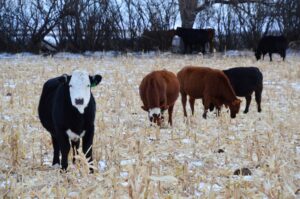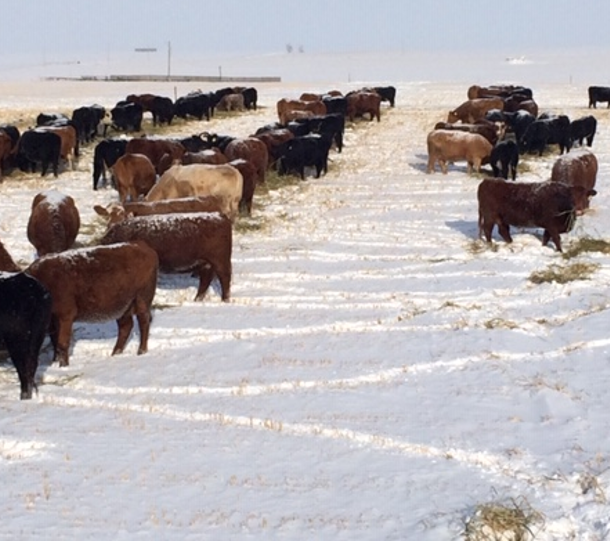Overextended Grazing 🎙️
This article written by Dr. Reynold Bergen, BCRC Science Director, originally appeared in the November 2024 issue of Canadian Cattlemen magazine and is reprinted on BeefResearch.ca with permission of the publisher.
CLICK THE PLAY BUTTON TO LISTEN TO THIS POST:
Listen to more episodes on BeefResearch.ca, Spotify, Apple Podcasts, Amazon Music or Podbean.
Last month’s column featured a University of Saskatchewan research trial that used high-moisture corn grain, snaplage or silage to partially replace barley grain or silage in finishing diets. While the steers were in the feedlot, this team wintered cows on the corn stover (Performance and ruminal fermentation of second-trimester pregnant beef cows fed short-season high-moisture corn stover or barley greenfeed during winter in western Canada; https://doi.org/10.1139/cjas-2023-0035).
What They Did

They planned to compare the performance of mature, pregnant cows (30 to 36 per diet) winter-grazed on snaplage residue, high-moisture corn stover, or whole-plant barley over two years. Corn was harvested in mid-October at 30% moisture, barley was swathed in mid-August at the hard dough stage, and grazing started in late November. Feed tests showed that corn stover contained less protein than whole-plant barley, so cows fed corn stover were supplemented with corn DDGS (1.1 lbs/head in 2020-21 and 4.3 lbs/head/d in 2021-22). Cows fed corn stover were given additional DDGS as an energy supplement when windchills dipped below -30oC (6 lbs/head/d in Year 1 and 4.2 lbs/head/d in Year 2). Cows fed whole-plant barley were supplemented with DDGS (2.4 lbs/head/d) during cold weather in Year 1 but not Year 2. Feed intakes, body weights and body condition scores were measured. Cattle had constant access to windbreaks, water, salt, mineral and vitamin supplements and were bedded as needed.
What They Learned
Grazed corn stover vs. barley swaths: In Year 1, an early snowstorm flattened and buried the snaplage residue, making it inaccessible to the cows. That treatment was scrapped. High winds, geese and deer wreaked havoc on the corn stover windrows, so a lot of the highly digestible leaves, dropped cobs and shattered grain were gone before grazing started. The barley swaths were much less impacted by the wind and wildlife. Electric fences were moved every three days to control access to swaths. Higher fiber levels meant that cows grazing corn stover ate less than cows grazing barley swaths. But because supplemental DDGS were used to make up for these nutritional differences, the corn stover and barley grazed cows gained the same amount of weight and maintained body condition score equally well. The winter grazing trial ended in mid-January when heavy snow followed by rain and ice made swath grazing impossible.
Baled corn stover vs. barley greenfeed: Year 2 was a drought, resulting in 75% lower swathed barley yields and 50% lower corn stover yields compared to Year 1. To avoid the wind and wildlife losses, in Year 2, the corn stover windrows and barley swaths were baled and fed in bale feeders. Again, the cows fed baled corn stover ate less than the cows fed barley greenfeed. This time the intake differences were due to differences in both fiber and moisture content. The barley greenfeed was baled at 13% moisture. The high-moisture corn grain was harvested at 30% moisture, but the moisture content of the stalk and leaves was much higher (nearly 50%). It was baled immediately afterwards (to rescue it from the wind and the King’s livestock). The high moisture content led to many moldy, spoiled and frozen-solid corn stover bales despite added preservative (propionic acid). The cows were unable to pick and choose the most digestible parts out of the frozen bales, so they simply ate whatever they could pull out. As a result, the barley greenfeed cows gained weight 82 lbs and maintained body condition while the cows fed corn stover bales didn’t gain weight and lost body condition. This trial ended in mid-January when the barley greenfeed bales ran out.
Bottom Line
With appropriate protein (and possibly energy) supplementation, corn stover could be a useful feed for wintering pregnant cows. Baling stover under Western Canadian conditions is challenging as the stage of maturity may not allow for sufficient drying to prevent mold.
So what does this mean (or NOT mean)… to you?

Extended winter grazing doesn’t always go according to plan. Wildlife don’t just consume feed; they consume the best feed. So, testing swaths when grazing begins (rather than when they’re swathed) more accurately predicts the nutrients your cows can consume. Many producers have learned that swath grazing isn’t the optimal extended winter grazing strategy when wildlife live in the neighborhood. Electric fencing to control access to swath (or bales) is extra work but helps ensure cows don’t consume all the most nutritious cobs, heads and leaves early in the grazing season, then have to survive on stalks in the depth of winter.
Have a Plan B – deeply buried and frozen swaths ended the first trial early, and a feed shortage ended the second trial early. Make sure you have stored backup feed in case extended winter grazing becomes impossible. Make sure your cattle are bedded when they need it (wasted feed may suffice), have natural or manmade shelter, and clean, loose snow or open water (frozen dugouts are very risky) to help them maintain weight and body condition and keep a 365-day calving interval. Doing the small things right is critical to ensure that low-cost winter grazing strategies don’t have a long-term cost.
The Beef Cattle Research Council is a not-for-profit industry organization funded by the Canadian Beef Cattle Check-Off. The BCRC partners with Agriculture and Agri-Food Canada, provincial beef industry groups and governments to advance research and technology transfer supporting the Canadian beef industry’s vision to be recognized as a preferred supplier of healthy, high-quality beef, cattle and genetics. Learn more about the BCRC at www.beefresearch.ca.
Click here to subscribe to the BCRC Blog and receive email notifications when new content is posted.
The sharing or reprinting of BCRC Blog articles is typically welcome and encouraged, however this article requires permission of the original publisher.
We welcome your questions, comments and suggestions. Contact us directly or generate public discussion by posting your thoughts below.